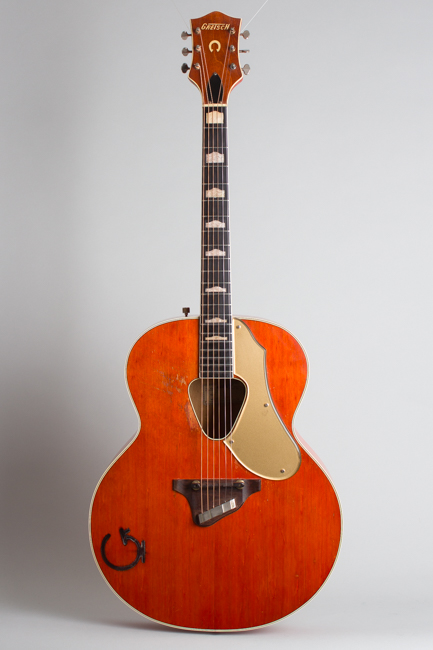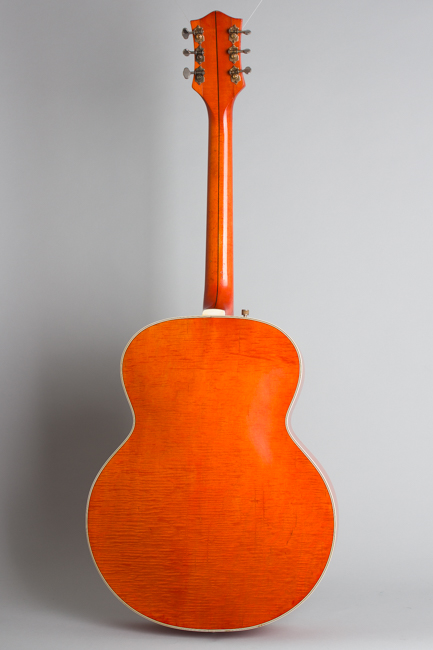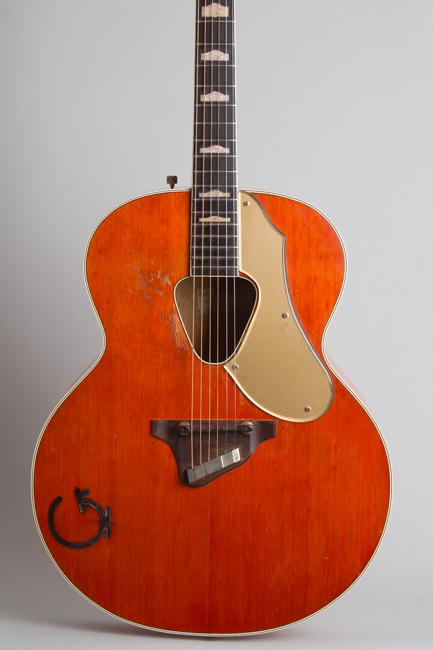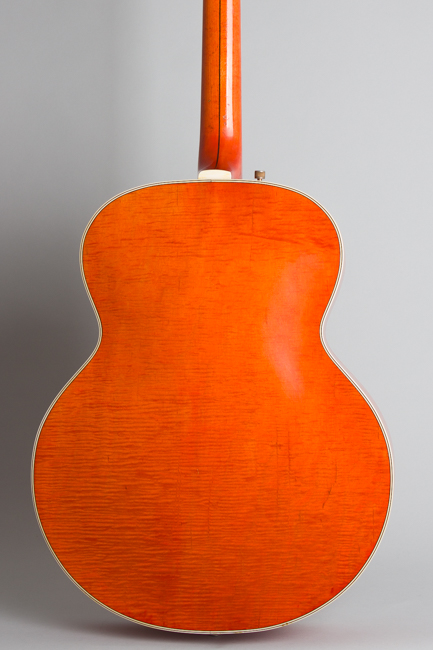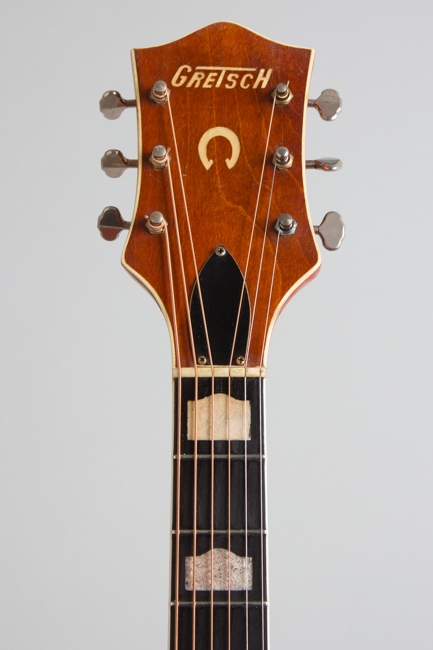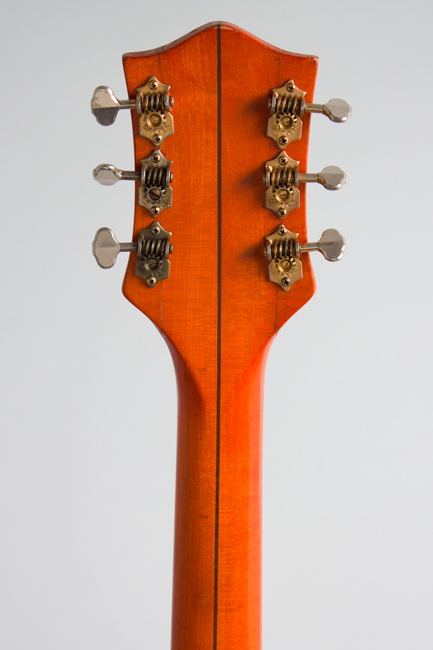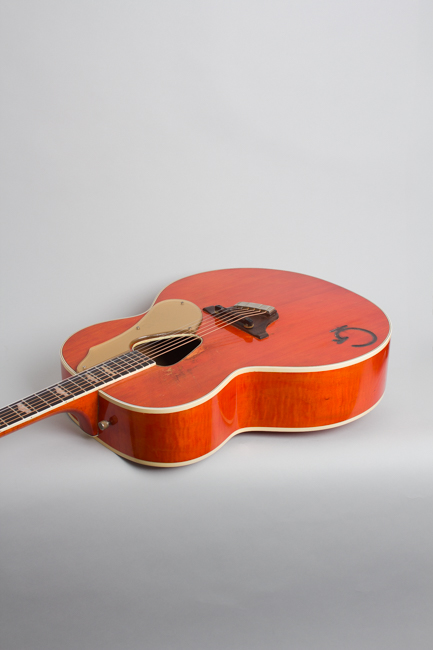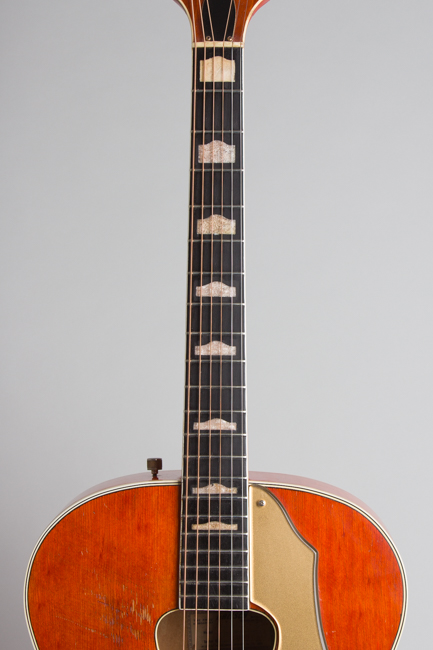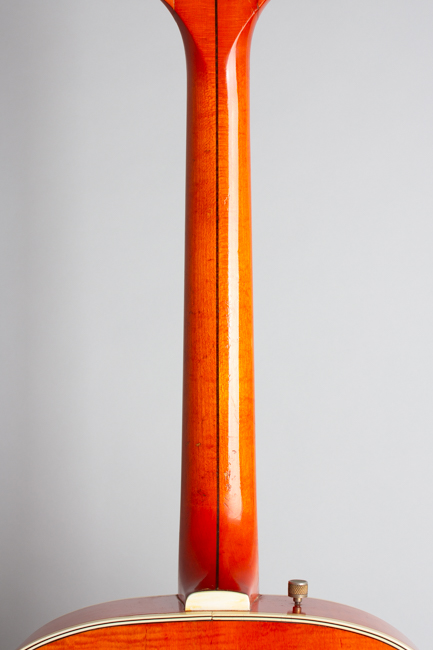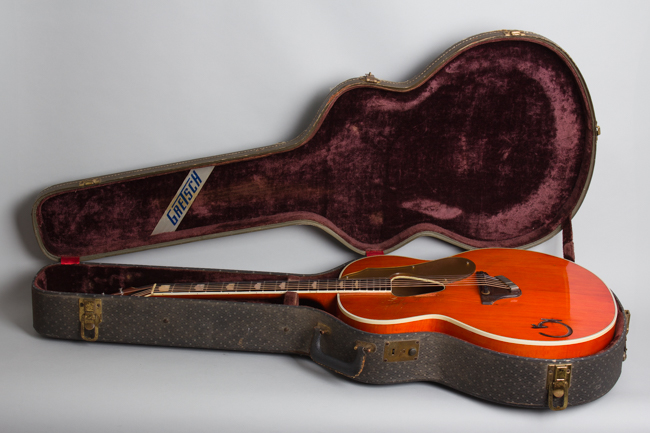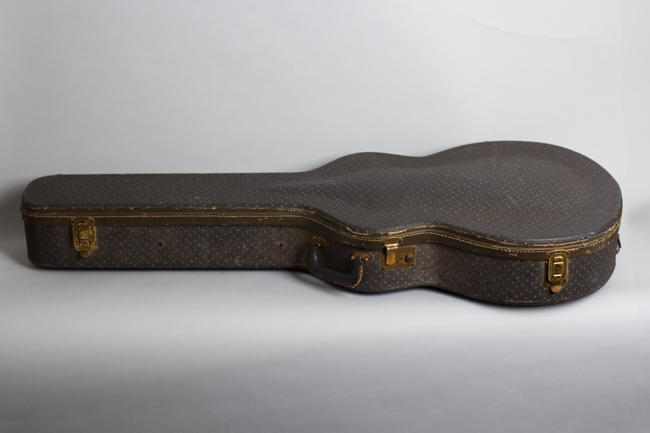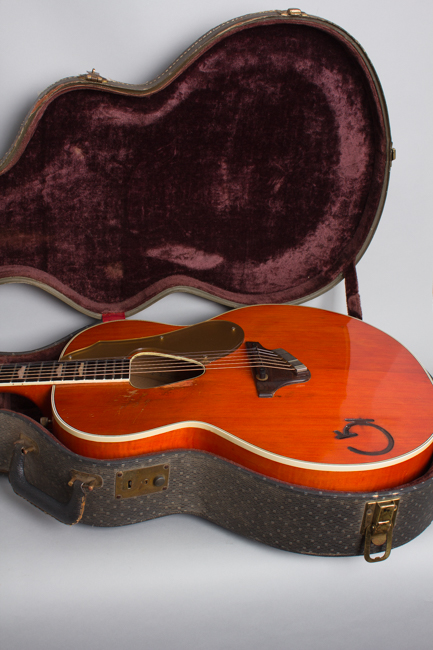Gretsch Model PX-6022 Rancher Flat Top Acoustic Guitar (1957)
This item has been sold.
Item # 12837
Prices subject to change without notice.
Gretsch Model PX-6022 Rancher Model Flat Top Acoustic Guitar (1957), made in Brooklyn, NY, serial # 23199, Western Orange lacquer finish, spruce top, laminated maple back and sides, laminated maple neck with rosewood fingerboard, original grey hard shell case.
If nobody has ever claimed the jumbo flat top Model 6022 Rancher is the best-sounding flat top of all time, it remains one of the most distinctive. The big "Western Orange" jumbo Rancher is an offbeat classic, one of the more unusual Gretsch designs of the 1950s. Basically this model is a "westernization" of the earlier Synchromatic Model 125/6021 Town & Country, a name presumably indicating its intended suitability for both urban and rural musical stylings! Starting in 1954 Gretsch produced this flashy Western-styled version specifically for the "Country" part of the equation, with many of the same cosmetic touches as the "Round-Up" model and subsequent Chet Atkins Model 6120. That guitar is far better remembered as a Gretsch classic, but the similarly styled Rancher is its acoustic doppelganger and shines in its reflected glory!
This 6022 was built in early 1957, with features specific to that year. It has a gold Lucite pickguard in place of the earlier decorated tortoise celluloid piece, a horseshoe inlay on the headstock instead of a steer's head and the distinctive Gretsch "hump block" inlay in the rosewood fingerboard. The arched back and sides are laminated maple, the back has some nice if subtle flame figure. The heavy ladder braced top is spruce with the signature vaguely triangular soundhole and large adjustable bridge with an integral metal tailpiece as the most distinctive features. The orange-finish top and back are four-ply bound, with a double-bound soundhole rim. The famous "G-brand" marking adorns the lower bass bout.
The 3-piece maple neck has a bound rosewood fingerboard. The headstock is single bound with an inlaid Gretsch T-roof logo and the small horseshoe above the truss rod cover. The Rancher is not a subtle guitar; it is big and heavily built, responding best to a vigorous strum! These were intended specifically to be rhythm instruments in Hillbilly combos and do work well in that role. This is certainly a striking instrument visually, an ultimate "front man" guitar. Sonically it will not convert anyone attached to their '50's Martin but does offer a fairly powerful midrangey rhythm kick and would also record well in this role.
Gretsch expert Ed Ball estimates no more than 450 of these were made in the 1950s, so they are fairly rare. Ranchers have had a few high-visibility gigs over then decades: Gene Vincent brandished one with a large (presumably accidental) extra hole in the top in many period photos, as did Australian rockabilly sprite Alis Lesley. A few decades on an early Rancher made a memorable cinematic impression in the hands of Robert Duvall for his Oscar-winning turn in the 1983 film "Tender Mercies". This one has some wear and tear but is structurally excellent, and as always looks about as cool as it gets!
Overall length is 43 3/8 in. (110.2 cm.), 17 1/8 in. (43.5 cm.) wide at lower bout, and 4 3/4 in. (12.1 cm.) in depth at side, taken at the end block. Scale length is 25 1/4 in. (641 mm.). Width of nut is 1 3/4 in. (44 mm.).
Overall length is 43 3/8 in. (110.2 cm.), 17 1/8 in. (43.5 cm.) wide at lower bout, and 4 3/4 in. (12.1 cm.) in depth at side, taken at the end block. Scale length is 25 1/4 in. (641 mm.). Width of nut is 1 3/4 in. (44 mm.).
This fairly rare Gretsch flat top shows general wear and repair but it remains a good playing instrument, structurally better than some. While not a mint collector's piece it is in fine gigging shape, a better player than some we have seen. The all-original finish has dings, dents and scrapes overall, most notably some heavier pick wear to the top largely above the soundhole. The rosewood bridge saddle is a replacement with an integral pickup allowing the guitar to function well plugged in; a jackhole for this was added in the lower rim. The original saddle is preserved in the case. The bridge has been reglued but is not lifting, which is a common issue with these.
The fingerboard has an odd repair; The original pearloid inlays were replaced with some sort of fill, probably because they were shrinking and lifting. This is visually noticeable but does not cause any functional issue, in fact the board feels smoother than it would have originally. For some reason the original Waverly tuners were replaced with period openback Grover Sta-tites; all else on the guitar appears original. The laminate seams at the base of the headstock wings have been resealed, again common on period Gretsch guitars. On the plus side there is NO binding rot on the instrument.
It is possible the beck has been reset, but if so it was a pretty clean job. The ivoroid heelcap was replaced. The original frets are still in good shape, recently crowned nicely and the instrument plays well with a fairly low action, easily adjustable in either direction and has the bonus of the added electrification for gigging purposes. This Yee-Haw Brooklyn jumbo flat top is one of Gretsch's more eccentric creations, not everyone's idea of a great acoustic but with a superb cool factor that spans the nearly decades since its creation. It resides in the original deluxe hard case. Very Good + Condition.
If nobody has ever claimed the jumbo flat top Model 6022 Rancher is the best-sounding flat top of all time, it remains one of the most distinctive. The big "Western Orange" jumbo Rancher is an offbeat classic, one of the more unusual Gretsch designs of the 1950s. Basically this model is a "westernization" of the earlier Synchromatic Model 125/6021 Town & Country, a name presumably indicating its intended suitability for both urban and rural musical stylings! Starting in 1954 Gretsch produced this flashy Western-styled version specifically for the "Country" part of the equation, with many of the same cosmetic touches as the "Round-Up" model and subsequent Chet Atkins Model 6120. That guitar is far better remembered as a Gretsch classic, but the similarly styled Rancher is its acoustic doppelganger and shines in its reflected glory!
This 6022 was built in early 1957, with features specific to that year. It has a gold Lucite pickguard in place of the earlier decorated tortoise celluloid piece, a horseshoe inlay on the headstock instead of a steer's head and the distinctive Gretsch "hump block" inlay in the rosewood fingerboard. The arched back and sides are laminated maple, the back has some nice if subtle flame figure. The heavy ladder braced top is spruce with the signature vaguely triangular soundhole and large adjustable bridge with an integral metal tailpiece as the most distinctive features. The orange-finish top and back are four-ply bound, with a double-bound soundhole rim. The famous "G-brand" marking adorns the lower bass bout.
The 3-piece maple neck has a bound rosewood fingerboard. The headstock is single bound with an inlaid Gretsch T-roof logo and the small horseshoe above the truss rod cover. The Rancher is not a subtle guitar; it is big and heavily built, responding best to a vigorous strum! These were intended specifically to be rhythm instruments in Hillbilly combos and do work well in that role. This is certainly a striking instrument visually, an ultimate "front man" guitar. Sonically it will not convert anyone attached to their '50's Martin but does offer a fairly powerful midrangey rhythm kick and would also record well in this role.
Gretsch expert Ed Ball estimates no more than 450 of these were made in the 1950s, so they are fairly rare. Ranchers have had a few high-visibility gigs over then decades: Gene Vincent brandished one with a large (presumably accidental) extra hole in the top in many period photos, as did Australian rockabilly sprite Alis Lesley. A few decades on an early Rancher made a memorable cinematic impression in the hands of Robert Duvall for his Oscar-winning turn in the 1983 film "Tender Mercies". This one has some wear and tear but is structurally excellent, and as always looks about as cool as it gets!
Overall length is 43 3/8 in. (110.2 cm.), 17 1/8 in. (43.5 cm.) wide at lower bout, and 4 3/4 in. (12.1 cm.) in depth at side, taken at the end block. Scale length is 25 1/4 in. (641 mm.). Width of nut is 1 3/4 in. (44 mm.).
Overall length is 43 3/8 in. (110.2 cm.), 17 1/8 in. (43.5 cm.) wide at lower bout, and 4 3/4 in. (12.1 cm.) in depth at side, taken at the end block. Scale length is 25 1/4 in. (641 mm.). Width of nut is 1 3/4 in. (44 mm.).
This fairly rare Gretsch flat top shows general wear and repair but it remains a good playing instrument, structurally better than some. While not a mint collector's piece it is in fine gigging shape, a better player than some we have seen. The all-original finish has dings, dents and scrapes overall, most notably some heavier pick wear to the top largely above the soundhole. The rosewood bridge saddle is a replacement with an integral pickup allowing the guitar to function well plugged in; a jackhole for this was added in the lower rim. The original saddle is preserved in the case. The bridge has been reglued but is not lifting, which is a common issue with these.
The fingerboard has an odd repair; The original pearloid inlays were replaced with some sort of fill, probably because they were shrinking and lifting. This is visually noticeable but does not cause any functional issue, in fact the board feels smoother than it would have originally. For some reason the original Waverly tuners were replaced with period openback Grover Sta-tites; all else on the guitar appears original. The laminate seams at the base of the headstock wings have been resealed, again common on period Gretsch guitars. On the plus side there is NO binding rot on the instrument.
It is possible the beck has been reset, but if so it was a pretty clean job. The ivoroid heelcap was replaced. The original frets are still in good shape, recently crowned nicely and the instrument plays well with a fairly low action, easily adjustable in either direction and has the bonus of the added electrification for gigging purposes. This Yee-Haw Brooklyn jumbo flat top is one of Gretsch's more eccentric creations, not everyone's idea of a great acoustic but with a superb cool factor that spans the nearly decades since its creation. It resides in the original deluxe hard case. Very Good + Condition.
